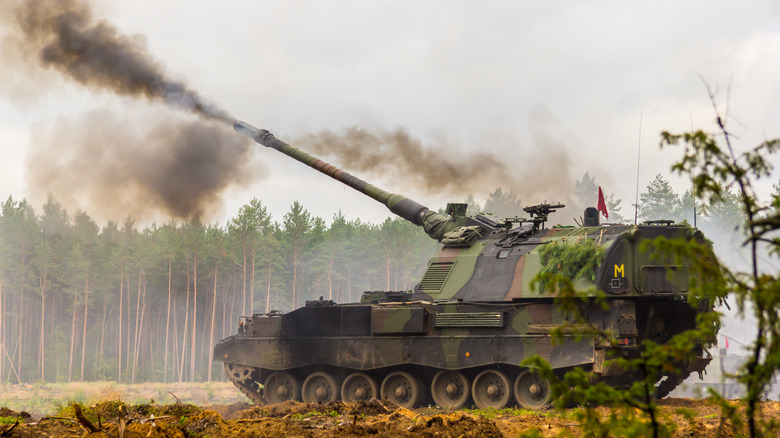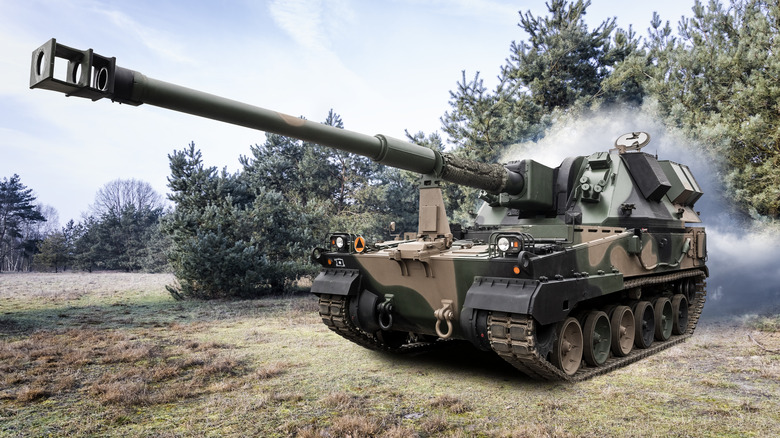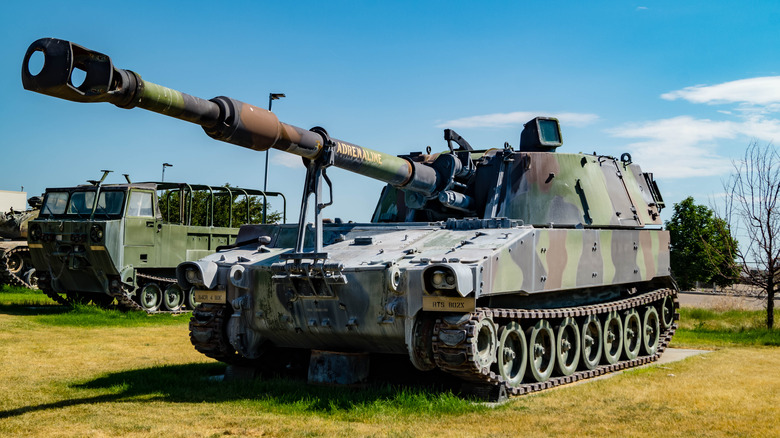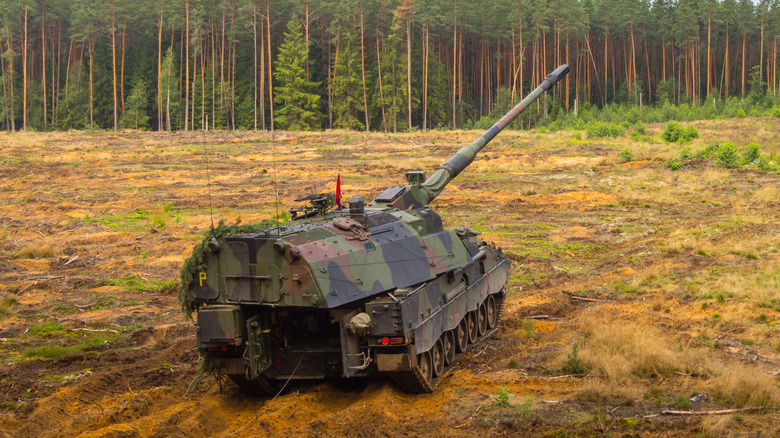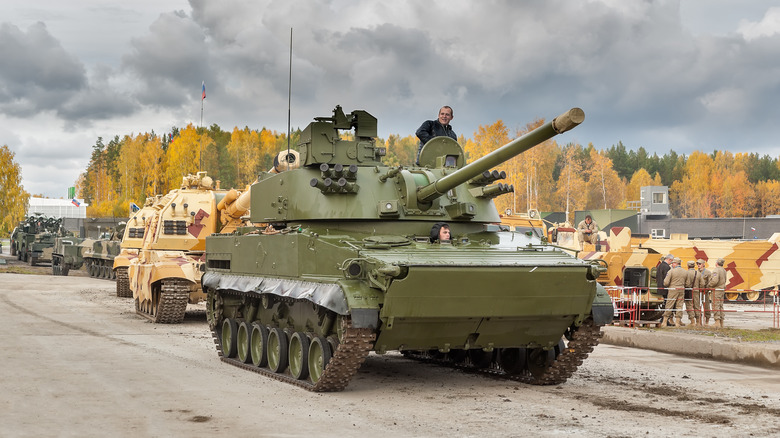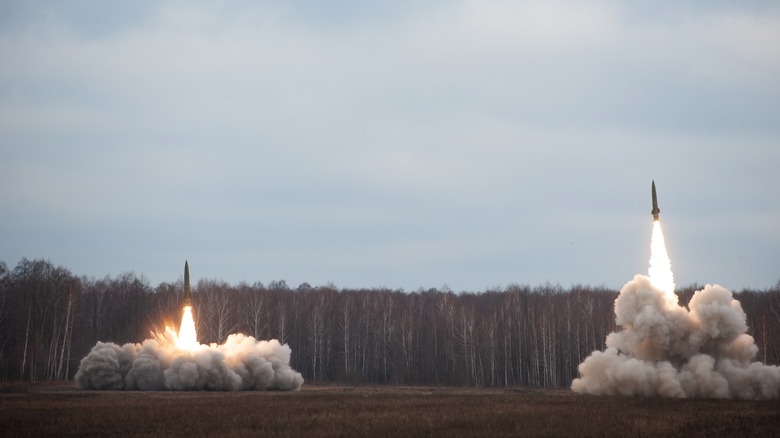The M1299 Howitzer: Why This Extended-Range Cannon Is So Important
As anyone keeping up with the war in Ukraine can tell you, artillery is still very much a force in modern warfare. They may be aided by GPS and drone observers, and the pieces may maneuver themselves around the battlefield instead of depending on trucks to haul them, but cannons that can obliterate a target from over the horizon without needing a battleship to carry them are still among the most devastating weapons the world's militaries have produced.
The lethality of the self-propelled howitzer has been continuously enhanced over the years, with increased range, deadlier payloads, faster firing rates, and better maneuverability. Since 1963, the U.S. Army has been using the M109 series of self-propelled howitzers, and as you might expect, Russia and China have both since come up with guns that can hit targets precisely from farther away than the latest M109 (the M109A7) can. This means in an artillery battle, they can stand off out of range and strike targets with impunity.
Clearly, this is a significant advantage, and America has been working on one-upping the competition for years. Shifting priorities at the Pentagon, however — specifically a new preference for lighter, highly mobile armored units — have kept a replacement for the M109 from being approved. But now the M1299 is about to enter service as the deadliest howitzer in the world.
The nuts and bolts
The M1299 self-propelled howitzer has a range of over 70 km when using the new XM1113 rocket-assisted rounds. When the new XM1115 round is developed, that range will increase to over 100 km. It can carry 23 rounds before being reloaded by its support vehicle and fire those rounds at 10 per minute when using its autoloader (which will make the artillery piece human-optional in the future). In keeping with the "shoot and scoot" philosophy of modern artillery, it can travel up to 60 km/hr on pavement for a total of 320 km before refueling. It is crewed by four soldiers: a commander, a driver, a gunner, and an ammunition handler. It can be equipped with a remote-controlled heavy machine gun or grenade launcher for close encounters.
Although it weighs close to the same as its direct predecessor, the M109A7, the M1299 has better armor, particularly around the gunner. It employs CBN protection for its crew, as well as fire suppression, further enhancing its survivability. It can fire up to eight rounds at varying angles so that they land on target simultaneously. By this time, the M1299 has already begun to move, reducing the effectiveness of counter-battery fire. Overall, the M1299 is a huge improvement on its predecessor, the M109A7 Paladin, and on par with the long-range howitzers fielded by China and Russia.
What it replaces
The direct predecessor of the M1299, the M109 self-propelled howitzer, was introduced in 1963. It was used in Vietnam in 1966, where it experienced widespread mechanical problems that couldn't be repaired in the field. The units were recalled, and in 1970, the model underwent the first of the many redesigns and upgrades that have kept the line operational until today. The M109 has been used by both the U.S. and many of its allies in conflicts such as the Gulf War, the Iraq War, and even by Iran in the Iran-Iraq War. It can move as fast as the new M1299 but has a maximum rate of fire of four rounds per minute.
By the time the M109 was on version A7, the Pentagon had already commissioned and rejected two replacement systems. The M109 was so thoroughly debugged by 2020 that, in designing the M1299, the Pentagon simply asked for the M777 stationary howitzer, which had recently doubled its range through the use of rocket-assisted projectiles, to be mounted on the M109A7 Paladin's frame. This, plus the addition of the new, more powerful ammunition and an auto-loader, yields what is essentially an M109, with its battle-tested armor and state-of-the-art mechanics, only with twice the range and 2.5 times the rate of fire.
The Crusader
One of the prototypes for a new self-propelled howitzer that was canceled before it went into production was the XM2001 Crusader. The Crusader featured many of the improvements present in the M1299, such as the 155mm barrel, the auto-loader, the NBC protection, and the fire suppression system. It moved impressively fast at 67 km/hr and had a mobile range of around 500 km. It was designed and tested in the closing years of the 20th century and was slated to enter service in 2008.
What doomed the Crusader was its weight. For all its speed and agility, the Crusader weighed as much as two M109s at a time when the Pentagon wanted to emphasize speed and rapid deployment. In 2002, with the war in Afghanistan declared "over," Secretary of Defense Donald Rumsfeld canceled the program, satisfied with neither the howitzer's precision nor its weight. It deserves mention, however, because the technology developed for the Crusader came in handy when the details of the experimental XM1299 were being worked out.
The competition
As stated earlier, the reason the U.S. insists on having an agile, mobile artillery piece with a range of 70 km is twofold: the Russian 2S35 Koalitsiya-SV and the Chinese PLZ-52 howitzer. Between Putin's war in Ukraine and Chinese fighter jets buzzing U.S. warplanes in the South China Sea, tensions between the three countries continue to remain high. For Russia or China to have artillery pieces that outclass America is a call to action for the Defense Department.
The Koalitsiya-SV is currently delayed in production due to the war in Ukraine and its subsequent sanctions on Russia. It is a very impressive weapon, however, with all the same crew protections as the M109A7, as well as similar speed as the M109, but with a 70 km range (with newly developed ammunition) and a rate of fire of eight rounds per minute. In a one-on-one artillery duel with an M109A7, the Koalitsiya-SV could stay just out of the M109's range and fire away.
China's PLZ-52 self-propelled howitzer has slightly less range than its American and Russian counterparts but can move faster (up to 70 km/hr), carries more ammo, and travels with a reconnaissance radar vehicle that uses Chinese Baidu satellite navigation to pinpoint enemy fire sources and provide rapid firing solutions. This, along with the PLZ-52's firing rate of eight rounds a minute, gives the Pentagon pause when they consider the prospect of an artillery battle between a PLZ-52 and an M109A7.
Future prospects
Military technology is constantly being improved, and the U.S. has already rejected two replacements for the M109. So, until it has been approved for service, we shouldn't be too certain about the future of this devastating weapon. It may well be that Chinese claims of a self-propelled howitzer with an effective range of 100 km are true. If that is the case, it will be back to the drawing board for U.S. defense engineers.
Currently, in its final stage of testing, there are currently only 20 M1299s in existence. The current schedule has the M1299 slated to be integrated into the Army's arsenal in 2025. No information is available on whether the M1299 will be sold to U.S. allies. In any case, that would not likely happen before America had fulfilled its own requirements, and since the Army owns almost a thousand M109s, it will take a while to replace them with M1299s completely.
